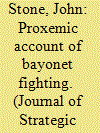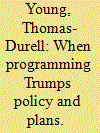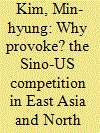|
|
|
Sort Order |
|
|
|
Items / Page
|
|
|
|
|
|
|
| Srl | Item |
| 1 |
ID:
149020


|
|
|
|
|
| Summary/Abstract |
A military cannot hope to improve in wartime if it cannot learn. Ideally, in wartime, formal learning ceases and the application of knowledge begins. But this is optimistic. In 1942, USAAF Eighth Air Force assumed it had the means necessary for victory. In reality, its technique and technology were only potentially – rather than actually – effective. What remained was to create the practice of daylight bombing – to learn. This article (1) recovers a wartime learning process that created new knowledge, (2) tests existing tacit hypotheses in military adaptation research, and (3) offers additional theoretical foundation to explain how knowledge is created in wartime
|
|
|
|
|
|
|
|
|
|
|
|
|
|
|
|
| 2 |
ID:
149018


|
|
|
|
|
| Summary/Abstract |
This article – based on interviews with Norwegian Provincial Reconstruction Team (PRT) commanders and the lessons-learned database of the Norwegian Armed Forces – argues that what appear to be an inability or unwillingness to learn and adapt in war may have other explanations. The ambiguity of experiences makes lessons contested, contradictory, and fluid interpretations of confusing events. Consequently, they do not provide unequivocal guidance for adaptation. Even when lessons learned are fairly clear and agreed upon, adaptation does not automatically follow, as force autonomy may be quite limited, at least for small states in coalition operations conducted in partnership with indigenous forces.
|
|
|
|
|
|
|
|
|
|
|
|
|
|
|
|
| 3 |
ID:
149019


|
|
|
|
|
| Summary/Abstract |
The bayonet has long been regarded as an obsolete piece of military technology. This article advances a proxemic account of close combat, which points to its continuing utility under modern battlefield conditions. It is argued that bayonet training remains an effective way of preparing soldiers to psychologically dominate contested spaces on the battlefield. Thus, although other weapons and techniques can fulfil the same role, it can nevertheless be argued that the bayonet’s enduring presence is not simply the result of some atavistic military mind-set.
|
|
|
|
|
|
|
|
|
|
|
|
|
|
|
|
| 4 |
ID:
149016


|
|
|
|
|
| Summary/Abstract |
The 1981 Defence Review undertaken by John Nott as Secretary of State for Defence controversially and dramatically cut the capabilities of the Royal Navy’s surface fleet. Many of those involved in these decisions have emphasised the budgetary and politico-strategic drivers for these reductions in capability, and the first generation of academic analysis has broadly followed this position. However, recently released government and private archival sources demonstrate that Nott’s review was initially much more severe than thought, and that this was due as much to the presumptions and assumptions of the key decision makers as to any strategic or budgetary factors.
|
|
|
|
|
|
|
|
|
|
|
|
|
|
|
|
| 5 |
ID:
149014


|
|
|
|
|
| Summary/Abstract |
Traditionally, policy and planning have been institutionally weak in the Naval Staff (Office of the Chief of Naval Operations – OPNAV). In their place, the N8 (Programming) has dominated resource decision-making, and, by default, decisions relating to policy and planning. Recent uncertainty over defense authorization and appropriations has resulted in calls for a greater role to be played by the N3/5, Policy and Plans Directorate. The article argues that reform of the Department of the Navy’s planning process is urgently needed. OPNAV’s weak planning and overly dominant programming practices are compared with those of the Departments of the Army and Air Force and are shown to be out of conformance with them. The article concludes with specific and detailed recommendations for reform of both the current planning and programming processes.
|
|
|
|
|
|
|
|
|
|
|
|
|
|
|
|
| 6 |
ID:
149017


|
|
|
|
|
| Summary/Abstract |
This article seeks to make sense of North Korean provocations in light of the Sino-US strategic competition in post-Cold War East Asia, where such variables as China’s rise, US’s pivot to Asia, and growing Sino-ROK economic ties are driving the strategic choices of major states in the region. The article examines the main motivations behind Pyongyang’s provocations since the end of the Cold War, discusses their implications for the Sino-US strategic competition in East Asia, and offers predictions about the future of North Korean provocations. The central thesis of the article is that Pyongyang has exploited the Sino-US strategic competition in East Asia for its regime survival. By raising North Korea’s strategic value to China, the intensifying Sino-US competition allows Pyongyang to continue provocations, regardless of Beijing’s explicit opposition.
|
|
|
|
|
|
|
|
|
|
|
|
|
|
|
|
|
|
|
|
|